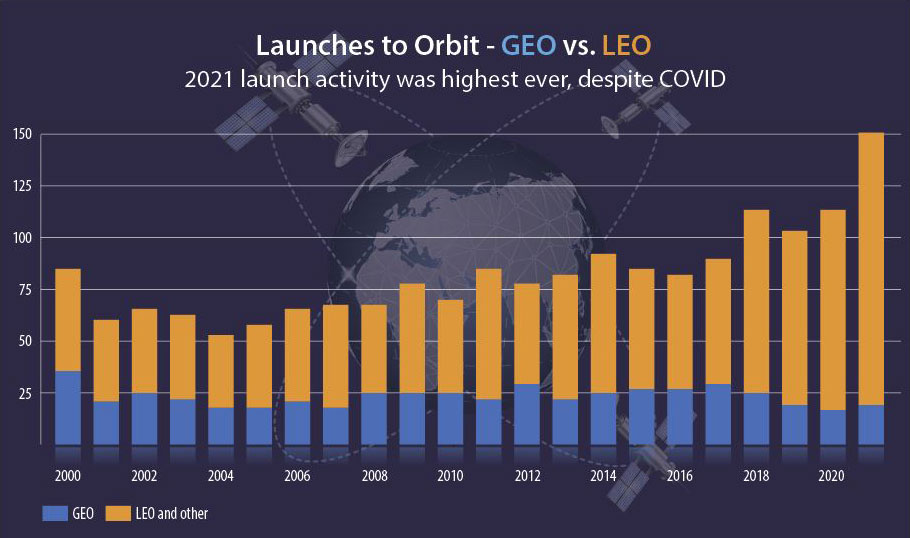 Satellite launches continue to increase, especially in LEO. Source: AXA XL, revised May 12, 2022
Satellite launches continue to increase, especially in LEO. Source: AXA XL, revised May 12, 2022
Ask any space insider: the risk of satellite failure for the 5,000 operational satellites in orbit today differs dramatically in Low Earth Orbit (LEO) compared with Geosynchronous Orbit (GEO) for many reasons, from how spacecraft are built, to their velocity and orbital direction, to how much space junk they must navigate around.
LEO vs. GEO in the age of large-scale constellations requires rethinking how the industry anticipates and handles mechanical and end-of-life events in today’s fast-evolving space networks. Sometimes failure IS an option if it means getting out in front of uncontrolled space debris with proper planning.
Most of these satellites – 80 percent – reside in LEO. This LEO popularity is a driver of a new economy while also posing the most risk for debris and spacecraft collisions. That’s why the global space community needs to understand the danger and work toward a common goal of space sustainability.
“Since the launch of Sputnik, humanity has launched a little over 10,000 satellites. Now, in the next decade, we’re launching 100,000 satellites, and most of these going to LEO,” notes Araz Feyzi, Co-founder and Chief Technology Officer of Kayhan Space, a Boulder, Colorado-based software firm specializing in autonomous satellite collision-avoidance solutions.
 Araz Feyzi, Co-Founder & CTO, Kayhan Space
Araz Feyzi, Co-Founder & CTO, Kayhan Space
“LEO is absolutely getting more crowded, and everybody agrees there is need for better traffic management and situational awareness,” agrees Stuart Daughtridge, Vice President of Advanced Technologies at Kratos Defense. “Beyond these requirements, the economics and the whole design and approach to failure are completely different in LEO and GEO.”
 Stuart Daughtridge, VP Advanced Technology, Kratos
Stuart Daughtridge, VP Advanced Technology, Kratos
Case in point: GEO satellites fly at altitudes of almost 36,000 kilometers without the need for reorientation since they follow the same circular orbit as the Earth’s rotation. They have traditionally been designed for 15-year lifetimes with radiation-hardened parts and redundant systems.
In contrast, today’s LEO fleets operate roughly 200 km to 2,000 km above the Earth’s surface. They are largely built cheaper for shorter mission life and make use of commercial off the shelf (COTS) components. In fact, before global supply chain shortages, constellation companies frequently relied on mass-produced automotive and cell phone industry components and chips instead of mil spec parts.
Finally, unlike GEO satellites, LEOs fly at much faster speeds because of the greater pull of gravity closer to the Earth. Some industry leaders say the compromise of reduced redundancy is worth the reward of more manufacturing speed and lower cost to support a business case for global coverage.
LEOs: Higher Failure Tolerances
“A LEO satellite constellation’s architecture supports a higher failure tolerance in that, if you have a LEO fleet of 100 satellites and you lose one, it’s not that big a deal. You lost 1% of your capability. If you have three GEO satellites covering the world, and one fails, you’ve lost service to a third of the world,” notes Daughtridge.
“GEO satellites also are very expensive to get up into orbit and, until recently, you couldn’t service your satellite once it was there,” he adds.
“Another dynamic unique to GEO is the level of radiation at that orbit, which can cause electronics to break down, necessitating radiation (rad)-hardened components,” explains Carolyn Belle, Director of Advanced Systems at Astroscale U.S., an on-orbit servicing provider.
 Carolyn Belle, Director, Advanced Systems, Astroscale
Carolyn Belle, Director, Advanced Systems, Astroscale
“GEOs and early LEO satellites featured system redundancy so if one system failed, a backup was available,” she adds, noting that redundancy is less common in today’s LEO platforms, which are built at much lower cost.
So, what are the current failure risks facing spacecraft in GEO and LEO, and are the ones facing LEO unique to that orbit?
Space insurance industry veteran Chris Kunstadter, global head of space at AXA XL, reports that, once in service on orbit, GEO satellites typically have a 1% annual failure rate compared to a 12% average failure rate for LEO satellites under 140 kg.
 Chris Kunstadter, Global Head of Space, AXA XL
Chris Kunstadter, Global Head of Space, AXA XL
“LEO failure rates are going to come down as people get better at building spacecraft,” he predicts.
When it comes to causes of failures in orbit, GEO satellite faults are mostly caused by an onboard failure, according to Kunstadter, “and an occasional hit by a micrometeoroid or debris.”
“In LEO it’s different. It’s a much more congested environment, so we have the same issues with features on these satellites, but there is the increased collision risk.”
To better assess that risk, his company is developing a tool to calculate the likelihood of a LEO collision based on factors such as the satellite’s altitude, satellite mass and constellation size. These spacecraft face heightened collision risk from the extreme velocities and random trajectories of objects traveling in LEO.
When two satellites are travelling toward one another at a combined velocity of 35,000 miles an hour, even the impact of a very small object can result in satellite failure, experts say.
Growing Problem of Orbital Debris
So, how bad is the debris problem? The U.S. Space Surveillance Network tracks about 25,000 objects the size of a few inches or larger circling Earth today. In 2019, it tracked 20,000 objects. The International Space Station (ISS) regularly conducts debris-avoiding maneuvers, including three in 2020 alone. In 2016, NASA described space debris as the top threat to satellites and astronauts.
Russia’s anti-satellite missile test last November spewed 1,700 more pieces of trackable orbital debris and hundreds of thousands of untrackable fragments into LEO, greatly increasing collision risks to astronauts, spacecraft and functioning satellites, and elevating space debris to a national security priority.
The more congested LEO becomes, the harder it will be to predict potential collisions. A May 2022 Space News Op-Ed by Boston Consulting Group estimated that the chance of a collision in LEO will grow sevenfold by 2030.
“Collision risk is everyone’s problem,” says Kunstadter.
Space Traffic Control
Kayhan Space is developing autonomous systems that can help avoid these costly collisions. The company’s new autonomous satellite collision avoidance system removes human error from the critical path showing 90% faster response time than manual efforts today.
Astroscale envisions a future where on-orbit servicing, including maneuvering defunct satellites out of busy orbits will be commonplace. Anticipating this trend, Astroscale has developed a docking plate that can be mounted on the outside of spacecraft to facilitate removal of these satellites when they reach end of life or no longer operate.
Belle also observes that the GEO community has begun to rethink the concept of repairing satellites rather than launching a replacement.
Kratos Defense’s top advanced technologist expressed excitement for the number of innovations on the horizon, especially artificial intelligence (AI). AI will assist in more effectively sorting different sources of data whether it’s RF, radar or even high-powered telescopes to provide better space domain awareness, though he cautioned that the AI systems are “only as good as the data in which these systems are fed.”
New Mindsets Needed
To make space a sustainable environment for all requires a “new mindset” for the entire space community, says Belle.
Kunstadter agrees, calling NASA’s 25-year post-mission disposal guideline out of touch with today’s realities of debris in LEO. He remains hopeful that the space community will come together and rally around common guidelines. One example of a move in this direction is the World Economic Forum’s Space Sustainability Rating.
“It will function like a LEED certification for buildings but apply to space operators and how responsible they are being in orbit,” he says.
“We’re no longer in a world where people can launch satellites and then abandon them – treating them as throwaway assets,” adds Astroscale’s Belle, explaining that the one-off satellite perspective of 20 years ago no longer applies.
“We need to think about the life cycle of not just the satellite, but the entire constellation or system. If we want to continue growing, we must have a safe environment,” she concludes.
Explore More:
The Role of LEO Constellations and the U.S. Government
Podcast: GPS, LEO and the Speed of Decision
SES: Owning a LEO Fleet Is No Longer Taboo, Expanding mPower Is 1st Priority
US FCC to Regulators: LEO Constellations Can’t Deny Coverage by Geography
